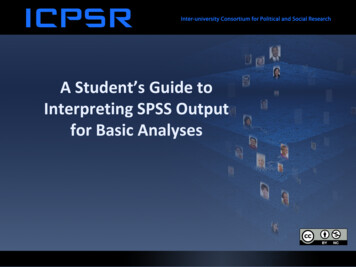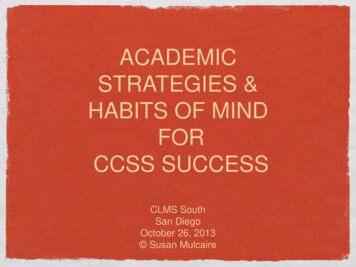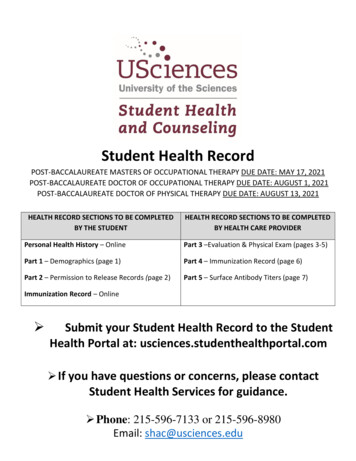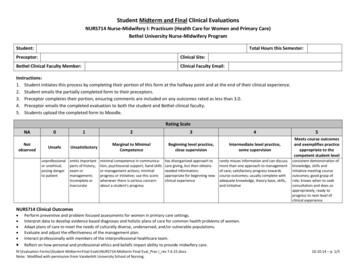
Transcription
A Student’s Guide toInterpreting SPSS Outputfor Basic Analyses
These slides give examples of SPSS output with notes aboutinterpretation. All analyses were conducted using the FamilyExchanges Study, Wave 1 (target dataset)1 from ICPSR. Theslides were originally created for Intro to Statistics students(undergrads) and are meant for teaching purposes only2. Formore information about the data or variables, please see:http://dx.doi.org/10.3886/ICPSR36360.v231 Fingerman, Karen.Family Exchanges Study Wave 1. ICPSR36360-v2. Ann Arbor, MI: Inter-university Consortium for Politicaland Social Research [distributor], 2016-04-14. http://doi.org/10.3886/ICPSR36360.v22 The text used for the course was The Essentials of Statistics: A Tool for Social Research (Healey, 2013).3 Some variables have been recoded so that higher numbers mean more of what is being measured. In those cases, an “r” isappended to the original variable name.
Frequency DistributionsFrequencies show how many people fall into each answer category on a given question(variable) and what percentage of the sample that represents.Number of people who respondedthat “child1” was marriedPercent of the total sample whoanswered that “child1” was marriedPercent of those with non-missingdata on this question who answeredthat “child1” was marriedNumber of people with valid (nonmissing) answers to the questionTotal number of people in thesurvey sampleCumulative percent adds thepercent of people answering in onecategory to the total of those in allcategories with lower values. It isonly meaningful for variablesmeasured at the ordinal orinterval/ratio level.
Crosstabulation Tables“Crosstabs” are frequency distributions for two variables together. The counts show howmany people in category one of the first variable are also in category one of the second andso on.Number of people who answered thattheir children are biologically related tothem and that their children need lesshelp than others their age.Marginal: Total number of people whoanswered that all of their children arebiologically related to them.Marginal: Total number of people whoanswered that their children need morehelp than others their age.Marginal: Total number of people whohad valid data on both D34r and A1A.
Crosstabulation Tables (Column %)Crosstabs can be examined using either row or column percentages and the interpretationdiffers depending on which are used. The rule of thumb is to percentage on yourindependent variable.Percent of the sample whose children areall biologically related to them that saidtheir children need less help than otherstheir age.Marginal: Percent of sample who feel thattheir children need less help than otherstheir age.Marginal: 100% here tells you that you’vepercentaged on columns.Can you interpret this number?(17.6% of those whose children were notall biologically related to them felt theirchildren needed more help than otherstheir age.)
Crosstabulation Table (Row %)Percent of those who said their childrenneed more help than others their agewhose children are all biologicallyrelated to them.Marginal: Percent of the sample whosechildren are biologically related to them.Marginal: 100% here shows that you areusing row percentages.Can you interpret this number?(17.4% of those who said their childrenneed about the same amount of help asothers their age had children who werenot all biologically related to themselves.)
Chi Square (𝚾𝚾 2 )Based on crosstabs, Χ2 is used to test the relationship between two nominal or ordinalvariables (or one of each). It compares the actual (observed) numbers in a cell to thenumber we would expect to see if the variables were unrelated in the population.Actual count (fo).Count expected (fe) if variables were unrelatedin pop.𝑟𝑟𝑟𝑟𝑟𝑟 ��𝑚𝑚𝑚 𝑥𝑥 𝑐𝑐𝑐𝑐𝑐𝑐𝑐𝑐𝑐𝑐𝑐𝑐 ��𝑚𝑚𝑚fe 𝑁𝑁Χ 2 value (obtained) 𝑓𝑓𝑓𝑓 𝑓𝑓𝑓𝑓 2𝑓𝑓𝑓𝑓This could becompared to a critical value (with the degreesof freedom) but the significance here tells youthat there appears to be a relationship betweenthe perceived amount of help needed andwhether the children are related to the R.Degrees of freedom ((# rows – 1)(# col – 1))The Χ2 test is sensitive to small expectedcounts, it is less reliable if fe is 5 for multiplecells.
Independent-samples T-testA test to compare the means of two groups on a quantitative (at least ordinal, ideallyinterval/ratio) dependent variable. Acomputed variable (dmean m) exists in this datasetthat is the average amount of support R offers mother across all domains (range 1-8); thatwill be the dependent variable.The number of females and males whohave non-missing data for dmean m.The actual mean and standarddeviation of dmean m for each of thegroups.T-value for the difference between 4.7233 and4.3656. t 𝑥𝑥1 𝑥𝑥2𝜎𝜎𝑥𝑥 𝑥𝑥where 𝜎𝜎𝑥𝑥̅ 𝑥𝑥̅ 𝜎𝜎21𝑁𝑁1 (Note, as long as the sig. of F is .05, use the“equal variances assumed” row, for reasonsbeyond the scope of these slides).𝜎𝜎22𝑁𝑁2.Significance (p) level for t-statistic. If p .05, thetwo groups have statistically significantly differentmeans. Here, females provide more support totheir mothers, on average, than do males.Confidence interval for the difference betweenthe two means. If CI contains 0, the differencewill not be statistically significant.
Paired-samples T-testLike the independent-samples t-test, this compares two means to see if they are significantlydifferent, but now it is comparing the average of same people’s scores on two differentvariables. Often used to compare pre- and post-test scores, time 1 and time 2 scores, or, as inthis case, the differences between the average amount of help Rs give to their mothersversus to their fathers.Mean amount of support R provided to mothers.Mean amount of support R provided to fathers.Number of cases with valid data for bothvariables. SPSS also gives the correlationbetween the two dependent variables, that wasleft off here for space.The difference between the average amount ofsupport provided to mothers and fathers andaccompanying standard deviation.T-statistic for the difference between the twomeans and the significance. In this sample,respondents provide significantly more supportto their mothers than to their fathers.
Oneway ANOVAAnother test for comparing means, the oneway ANOVA is used when the independentvariable has three or more categories. You would typically report the F-ratio (and sig.) anduse the means to describe the groups.Number of cases in each group of theindependent variable.Average amount of support provided (andstandard deviation) by those with incomes 10k.Average amount of support provided by all521 people with valid data on dmean m.Confidence Interval: the range within whichyou can be 95% certain that the group’smean falls for the population.Variability of means between the groups:Mean Square Between 𝑆𝑆𝑆𝑆𝑆𝑆where SSB 𝑑𝑑𝑑𝑑𝑑𝑑2 𝑁𝑁𝑘𝑘 (𝑥𝑥̅𝑘𝑘 𝑥𝑥)̅ and dfb k-1. (k is numberof groups; 𝑁𝑁𝑘𝑘 is # people in a given group;𝑥𝑥̅𝑘𝑘 is mean for that group)Total Sum of Squares (SST) SSB SSWVariability within each group: WithinGroups Mean Square 𝑆𝑆𝑆𝑆𝑆𝑆where SSW 𝑑𝑑𝑑𝑑𝑑𝑑SST-SSB and dfw N-k.F-statistic (and associated p-value) test the null hypothesis that all groups have the samemean in the population. A significant F means that at least one group is different than theothers. Small within groups variance and large between groups produces a higher F –value: F 𝑀𝑀𝑀𝑀𝑀𝑀𝑀𝑀 𝑠𝑠𝑠𝑠𝑠𝑠𝑠𝑠𝑠𝑠𝑠𝑠 ��𝑏. Here we see that at least one group’s mean amount of support is𝑀𝑀𝑀𝑀𝑀𝑀𝑀𝑀 𝑠𝑠𝑠𝑠𝑠𝑠𝑠𝑠𝑠𝑠𝑠𝑠 icantly different than the others. Additional (post-hoc) tests can be run to determinewhich groups are significantly different than each other.
CorrelationPearson’s r: measures the strength and direction of association between two quantitativevariables. Matrices are symmetric on the diagonal.Correlation coefficient (r) tells how strongthe relationship is and in what direction.Range is -1 to 1, with absolute values closerto 1 indicating stronger relationships. Here,the frequency of visits is moderately relatedto the amount of emotional support given tothe mother; more visits correlate with morefrequent emotional support.r (𝑥𝑥 𝑥𝑥)(𝑦𝑦 𝑦𝑦)2 (𝑦𝑦 [ (𝑥𝑥 𝑥𝑥)𝑦𝑦)2Significance (p) tells how certain you can bethat the relationship displayed is not due tochance. Typically look for this to be .05.N sample size: this number may be differentin each cell if missing cases are excludedpairwise rather than listwise.Can you interpret this number? (Howoften mother forgets to ask about R’s life isnegatively, albeit weakly, related to theamount of emotional support R gives mother– If mother forgets to ask a great deal of thetime, she gets less emotional support fromR.)
Bivariate Regression (model statistics)Examines the relationship between a single independent (“cause”) variable and adependent (outcome) variable. While it’s good to look at all numbers, the ones youtypically interpret/report are those boxes marked with an * (true for all following slides).Regression line: 𝑦𝑦 𝑎𝑎 𝑏𝑏 𝑥𝑥 .Independent (predictor) and Dependent variables.Multiple correlation (R): in bivariate regression, sameas standardized coefficientCoefficient of determination (R2 ): the amount ofvariance in satisfaction with help given to mother thatis explained by how often the R saw mother. R2 (TSS– SSE)/ TSS. *Total Sum of Squares (TSS) (𝑦𝑦 𝑦𝑦) 2.Residual sum of squared errors (or Sum of SquaredErrors, SSE) (𝑦𝑦 𝑦𝑦) 2.F-value (and associated p-value) tells whether model isstatistically significant. Here we can say that therelationship between frequency of visits with onesmother and satisfaction with help given is significant;it is unlikely we would get an F this large by chance. *
Bivariate Regression (coefficients)Y-intercept (a): value of y when x is 0.Slope (b): how much y chances foreach unit increase in x. Here, for everyadditional “bump up” in frequency ofvisits, satisfaction with the amount ofhelp given to mother increases by.157. *Standard error of the estimate: divide theslope by this to get the t-value. *Standardized coefficient (β): influence of x ony in “standard units.”Confidence Interval – the slope /- (criticalt-value * std. error) – shows that you canbe 95% confident that the slope in thepopulation falls within this range. If rangecontains 0, variable does not have aneffect on y.T-statistic (and associated p-value) tellswhether the individual variable has asignificant effect on dependent variable. *The regression equation (for this modelwould be 𝑦𝑦 1.770 .157(𝑥𝑥).
Multiple Regression (OLS: model statistics)Used to find effects of multiple independent variables (predictors) on a dependent variable.Provides information about the independent variables as a group as well as individually.Regression line: 𝑌𝑌 ′ a 𝑏𝑏1 𝑥𝑥1 𝑏𝑏2 𝑥𝑥2 𝑏𝑏3 𝑥𝑥3 R multiple correlation. The association between the group ofindependent variables and the dependent variable. Ranges from 0-1.R2 and Adjusted R2– how much of the variance in satisfaction withamount of help R provided mother is explained by the combination ofindependent variables in the model. Also called “coefficient ofdetermination.” R2 (TSS – SSE)/ TSS. Adjusted R2 compensates for theeffect that adding any variable to a model will raise the R2 to somedegree. About 14% of the variance in satisfaction is accounted for byfinancial and emotional support, seeing mother in person, and whethermother makes demands on R. *Residual sum of squared errors (or Sum of Squared Errors, SSE) (𝑦𝑦 𝑦𝑦) 2.Total Sum of Squares (TSS) (𝑦𝑦 𝑦𝑦) 2.Df1 # of independent variablesDf2 # of cases – (# of independent variables 1)F-value and associated p-value tells whether model is statisticallysignificant (chance that at least one slope is not zero in the population).This combination of independent variables significantly predictssatisfaction with amount of help R gives mother. *
Multiple Regression (coefficients)Y-intercept (a): value of y when all Xs are 0.Slope (b): how much satisfaction changes foreach increase in frequency of visiting mother. *Standard error of the estimate: divide theslope by this to get the t-value. *Standardized coefficient (β): influence of x on y in“standard units.” Can use this coefficient tocompare the strength of the relationships of eachof the independent variables to the dependent.Largest β strongest relationship, so herefrequency of visits has the strongest relationship tosatisfaction, all else constant.T-statistic (and associated p-value) tells whether theindividual variable has a significant effect ondependent variable, controlling for the otherindependent variables. *Regression Equation: 𝑦𝑦 1.477 .130 b3ar .195(m 6) .009 d1r .033(d22r)Zero-order correlation Pearson’s r. Bivariaterelationship between frequency of visits andR’s satisfaction w/ help R’s given to mother.Partial correlation: bivariate relationshipbetween frequency of visits and R’ssatisfaction, controlling for demands mothermakes and emotional/financial support given.
OLS with Dummy VariablesUsing a categorical variable broken into dichotomies(e.g., race recoded into white, black, other with eachcoded 1 if R fits that category and 0 if not) aspredictors. In this case, the amount of help Rperceives his/her adult child to need was recodedinto 1 “more than others” and 0 “less or aboutthe same as others.” If the concept is representedby multiple dummy variables, leave one out as thecomparison group (otherwise there will be perfectmulticollinearity in the model).Dummy variable. Children who need less or the same amount ofhelp as their peers is the reference category (0).Slope is interpreted as the amount of difference between the “0”group and the “1” group. Here, those who perceive theirchildren needing more help than their peers are .321 moresatisfied with the amount of help they give their mother thanthose whose children require less help, controlling for frequencyof visiting mother, demands made, and emotional and financialsupport provided (and the difference is statistically significant).
A Student’s Guide to Interpreting SPSS Output for Basic Analyses. These slides give examples of SPSS output with notes about interpretation. All analyses were conducted using the Family E











